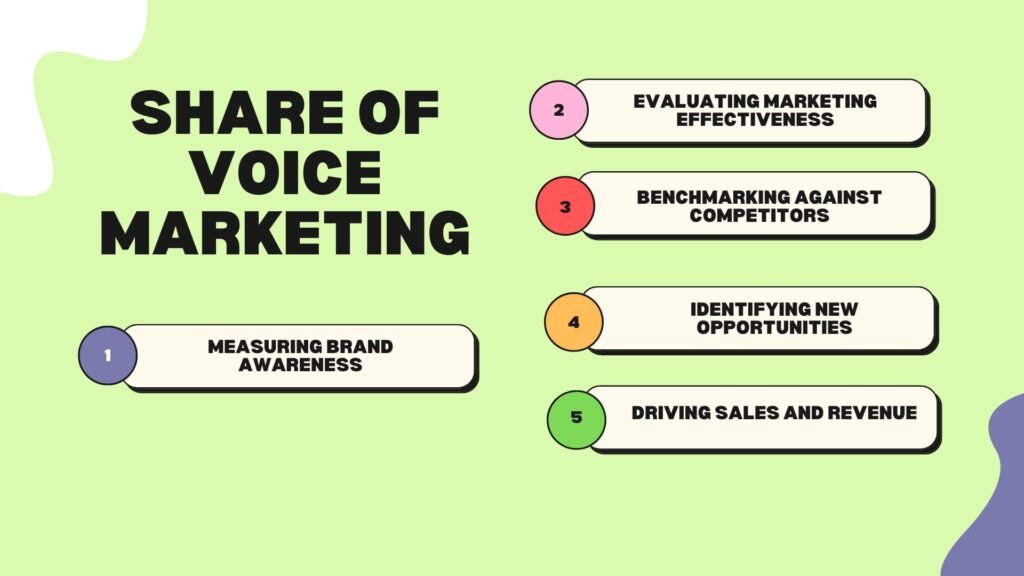
In today’s fast-paced world, competition is intense, and brands are vying for consumers’ attention. With so much noise in the marketplace, how can a brand ensure its message is heard above the rest? This is where Share of Voice (SOV) marketing comes in.
This blog will explore the Share of Voice marketing concept, its importance, how to measure it, and strategies to increase it.
So, let’s dive in.
What Is Share Of Voice Marketing?

Share of Voice (SOV) marketing is a metric used to measure a brand’s visibility in the marketplace. It shows how much of the conversation in a particular industry or market a brand is a part of.
It’s crucial for brands as it allows them to understand their position in the marketplace and how they compare to their competitors. By measuring SOV, a brand can see where it is succeeding and where it needs to improve.
Moreover, most are confused with market share, but no worries. We will help you clear it.
Let’s have a clear understanding of both of them.
Difference Between Share Of Voice And Market Share
Share of Voice and Market Share are two metrics marketers use to evaluate the success and effectiveness of their marketing strategies. While they are related, they are not the same thing.
Share of Voice (SOV) measures a brand’s visibility in the marketplace through social media, advertising, content, and public relations. It shows how much of the conversation in a particular industry or market a brand is a part of.
SOV is important for brands as it allows them to understand their position in the marketplace and how they compare to their competitors.
On the other hand, Market Share is the percentage of total sales in a market that a particular company or brand has.
It shows the portion of the market that a company or brand controls. Market share is essential for companies as it allows them to understand how much of the market they have captured and how they compare to their competitors.
Now that you know the meaning of both, let’s understand a few differences between the terms;
Here are four differences between the Share of Voice and Market Share:
- Definition
Share of Voice captures the brand’s visibility, while Market Share gauges the sales portion. It measures overall conversation, while the latter calculates market sales dedication. SOV assesses the brand’s overall presence and perception; Market Share quantifies revenue and customer acquisition. One examines brand visibility and buzz, While the other evaluates financial success.
- Focus
Share of Voice captures the brand’s visibility, while Market Share gauges the sales portion. It measures overall conversation, while the latter calculates market sales dedication. SOV assesses the brand’s overall presence and perception; Market Share quantifies revenue and customer acquisition. One examines brand visibility and buzz, While the other evaluates financial success.
- Time Frame
SOV is flexible, measured promptly and continuously, and Market Share tends to be assessed quarterly or annually. It permits real-time evaluation and ongoing insights, providing long-term sales perspectives and insights. SOV offers up-to-date brand perception and trends; Market Share reveals periodic sales performance and trends.
- Metrics
SOV employs mentions, reach, and engagement to measure, and Market Share relies on sales revenue and sold units to ascertain. It uses qualitative factors like social media mentions and buzz, while the latter employs quantitative factors such as financial indicators and market share. SOV quantifies brand awareness and interaction; Market Share quantifies revenue and dominance.
Importance Of Share Of Voice For Brands

Here are five key reasons why SOV is significant for brands:
- Measuring Brand Awareness
It is an essential metric for measuring brand awareness. It helps brands to understand how much of the conversation in their industry or market they are a part of.
This can help them to identify opportunities to increase their brand’s visibility and awareness.
- Evaluating Marketing Effectiveness
It can also be used to evaluate the effectiveness of a brand’s marketing strategies.
By monitoring their SOV over time, brands can see how well their marketing efforts resonate with their target audience and adjust their strategies as needed.
- Benchmarking Against Competitors
It allows brands to benchmark themselves against their competitors. By comparing their SOV to their competitors, brands can see how they perform in the marketplace and identify areas where they need to improve.
- Identifying New Opportunities
It can also help brands to identify new opportunities in the marketplace. By monitoring the conversation and trends in their industry, brands can identify areas where there is a gap in the market and develop strategies to fill that gap.
- Driving Sales And Revenue
Ultimately, It can help brands drive sales and revenue. By increasing their visibility and market presence, brands can attract and retain new customers. This, in turn, can lead to increased sales and revenue over time.
What Are Some Examples Of Brand Voice?

Brand voice refers to the distinct personality, tone, and style a brand uses to communicate with its audience. It encompasses the language, messaging, and overall vibe that reflects the brand’s values, identity, and target market. Here are some examples of different brand voices:
- Apple: Apple’s brand voice is sleek, sophisticated, and minimalist. It emphasizes simplicity, elegance, and innovation. Apple’s messaging focuses on user experience and often includes phrases like “Think different” and “Designed in California.”
- Nike: Nike’s brand voice is inspirational, empowering, and energetic. It often uses powerful and motivational language to encourage customers to push their limits and achieve their goals. Their famous “Just Do It” tagline embodies their brand voice.
- Wendy’s: Wendy’s, a fast-food chain, is known for its sassy and humorous brand voice on social media. They engage in witty banter, playful insults, and pop culture references to connect with their audience and stand out in the competitive fast-food industry.
How To Measure Share Of Voice?

Measuring SOV involves tracking a brand’s visibility in the marketplace and comparing it to the visibility of its competitors.
Several steps are involved in measuring SOV:
- Determine The Relevant Metrics
The first step in measuring SOV is determining the metrics to track a brand’s visibility. That might include metrics such as
- social media mentions,
- website traffic,
- search engine rankings or
- media coverage, etc.
- Identify Competitors
The next step is to identify the brand’s competitors in the marketplace. That might include direct competitors as well as indirect competitors.
- Collect Data
Once the metrics and competitors have been identified, it’s time to collect data. That might use tools such as Google Analytics, social media monitoring tools (Sprout Social, Hootsuite), or media monitoring tools to track the relevant metrics.
- Calculate SOV
Once the data has been collected, it’s time to calculate the brand’s SOV. That can be done by dividing the brand’s total mentions, traffic, or other relevant metrics by the total mentions, traffic, or other relevant metrics for all competitors in the market.
- Analyze Results
Finally, it’s crucial to analyze the SOV measurement results. That might involve comparing the brand’s SOV to its competitors and identifying areas where it performs well and needs improvement.
Strategies To Increase Share Of Voice
Here are a few strategies that can help you increase your SOV;
Increase Advertising Spending
One of the most effective ways to increase your SOV is by increasing advertising spending.
By investing in more ads, you can increase the number of times your brand is mentioned, leading to higher visibility and awareness.
Focus On Social Media
Social media platforms offer an excellent opportunity to increase the SOV. Creating engaging and shareable content can increase brand mentions and conversations around your brand.
You can also leverage social media influencers to amplify your brand message and increase reach.
Partner With Industry Influencers
Collaborating with influencers and thought leaders in your industry can help you reach new audiences and increase your SOV.
By partnering with influencers, you can tap into their audience and leverage their credibility and authority to increase your brand’s visibility.
More Reads – How To Become An Influencer: An Ultimate Guide For 2023
Optimize Your SEO
Search engine optimization (SEO) is another effective way to increase the SOV. Optimizing your website and content for relevant keywords can increase your visibility in search engine results pages, leading to more brand mentions and traffic.
Leverage PR And Media Coverage
Media coverage can significantly impact your brand’s SOV. You can increase your brand’s visibility and credibility by generating positive media coverage through press releases, media outreach, and other PR tactics.
Create Compelling Content
Creating compelling and shareable content can help increase brand mentions and conversations around your brand. By creating valuable content that resonates with your target audience, you can increase your brand’s visibility and position your brand as a thought leader in your industry.
Overall, increasing the SOV requires a comprehensive approach that includes a mix of marketing tactics.
However, By adopting a holistic approach and executing the strategies effectively, you can increase your brand’s SOV and gain a competitive edge in your industry.
Final Thoughts
Now that you have to know what share of voice marketing is try to identify your brands.
If you have any questions regarding the topic, please leave them in the comment section. We will be happy to answer you.
Thanks for reading 🙂
Also, Read – Nostalgia Marketing: Include Everything You Need To Know–
How To Use Hashtag Marketing Effectively In 2023








No Comments